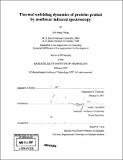Thermal unfolding dynamics of proteins probed by nonlinear infrared spectroscopy
Author(s)
Chung, Hoi Sung
DownloadFull printable version (12.28Mb)
Other Contributors
Massachusetts Institute of Technology. Dept. of Chemistry.
Advisor
Andrei Tokmakoff.
Terms of use
Metadata
Show full item recordAbstract
This thesis presents spectroscopic approaches to study the thermal unfolding dynamics of proteins. The spectroscopic tool is nonlinear infrared (IR) spectroscopy of the protein amide I band. Among various nonlinear IR techniques, two-dimensional infrared (2D IR) spectroscopy, which is an IR analogue of 2D NMR, is the most informative. A 2D IR spectrum is obtained from a double Fourier transform of the heterodyned third-order nonlinear signal, which is generated by three consecutive interactions between femtosecond IR pulses and the vibrations of the system. This technique is sensitive to the presence of P-sheet structure in proteins through the formation of cross peaks between the two characteristic vibrational modes of 0-sheets. In this work, 2D IR spectroscopy is used to measure equilibrium thermal unfolding of ribonuclease A and ubiquitin. For transient unfolding studies, the temperature of the solution is rapidly raised by a nanosecond temperature jump (T-jump) laser, which is followed by probing structural changes of proteins with dispersed vibrational echo (DVE) spectroscopy or 2D IR spectroscopy. (cont.) DVE spectroscopy is a homodyne measurement of the third-order signal, in which the spectrum is related to a projection of a complex 2D IR spectrum onto one of the frequency axes (03). In spite of its reduced dimension measurement, DVE spectroscopy is sensitive enough to be utilized in transient probing with less experimental challenges. From transient thermal unfolding studies of ubiquitin probed by DVE spectroscopy, complicated non-exponential relaxations are observed on the microsecond timescale, which are followed by ms unfolding. Non-exponential relaxation is interpreted as downhill unfolding of a transient species populated around the top of a barrier (transition state) due to the barrier shift caused by a rapid T-jump. Variations in the unfolding transition state of ubiquitin are further investigated with temperature-dependent T-jump experiments and mutation studies. Experimental conclusions are supported by calculations of the unfolding free energy surfaces using statistical mechanical modeling. T-jump 2D IR spectroscopy is also performed to remove ambiguities in the projected domain of DVE spectroscopy and provide a new spectroscopic measure for transient unfolding through line-broadening analysis.
Description
Thesis (Ph. D.)--Massachusetts Institute of Technology, Dept. of Chemistry, 2007. Vita. Includes bibliographical references.
Date issued
2007Department
Massachusetts Institute of Technology. Department of ChemistryPublisher
Massachusetts Institute of Technology
Keywords
Chemistry.